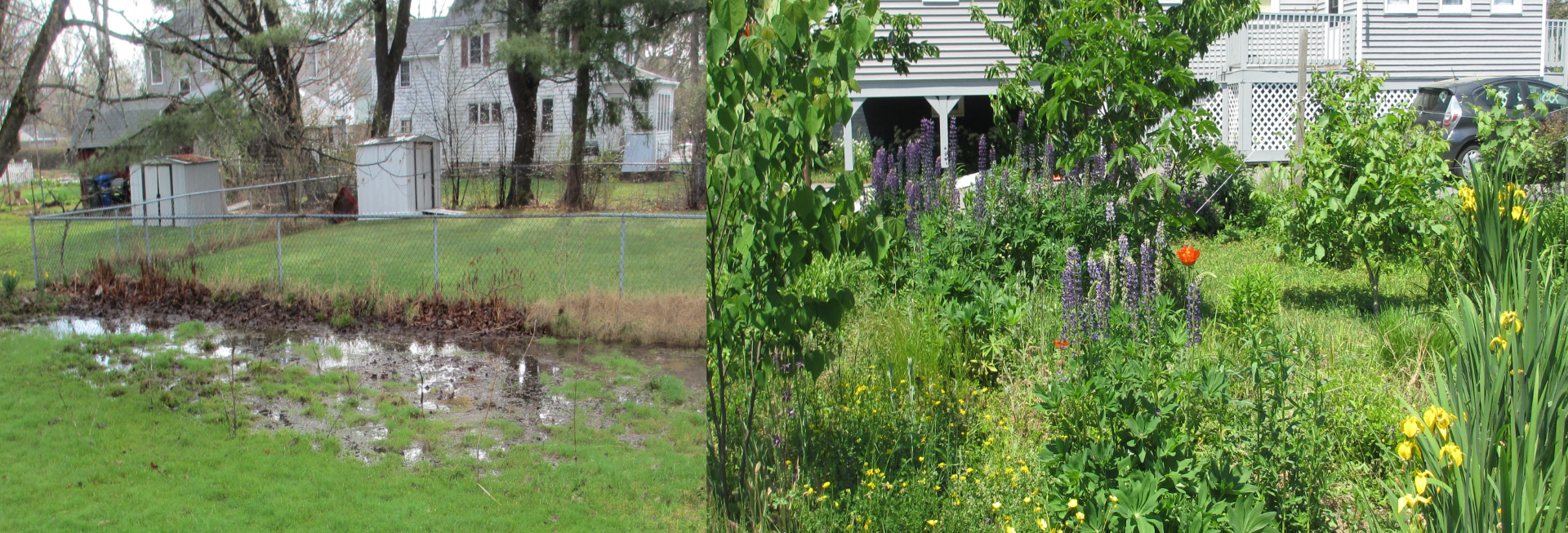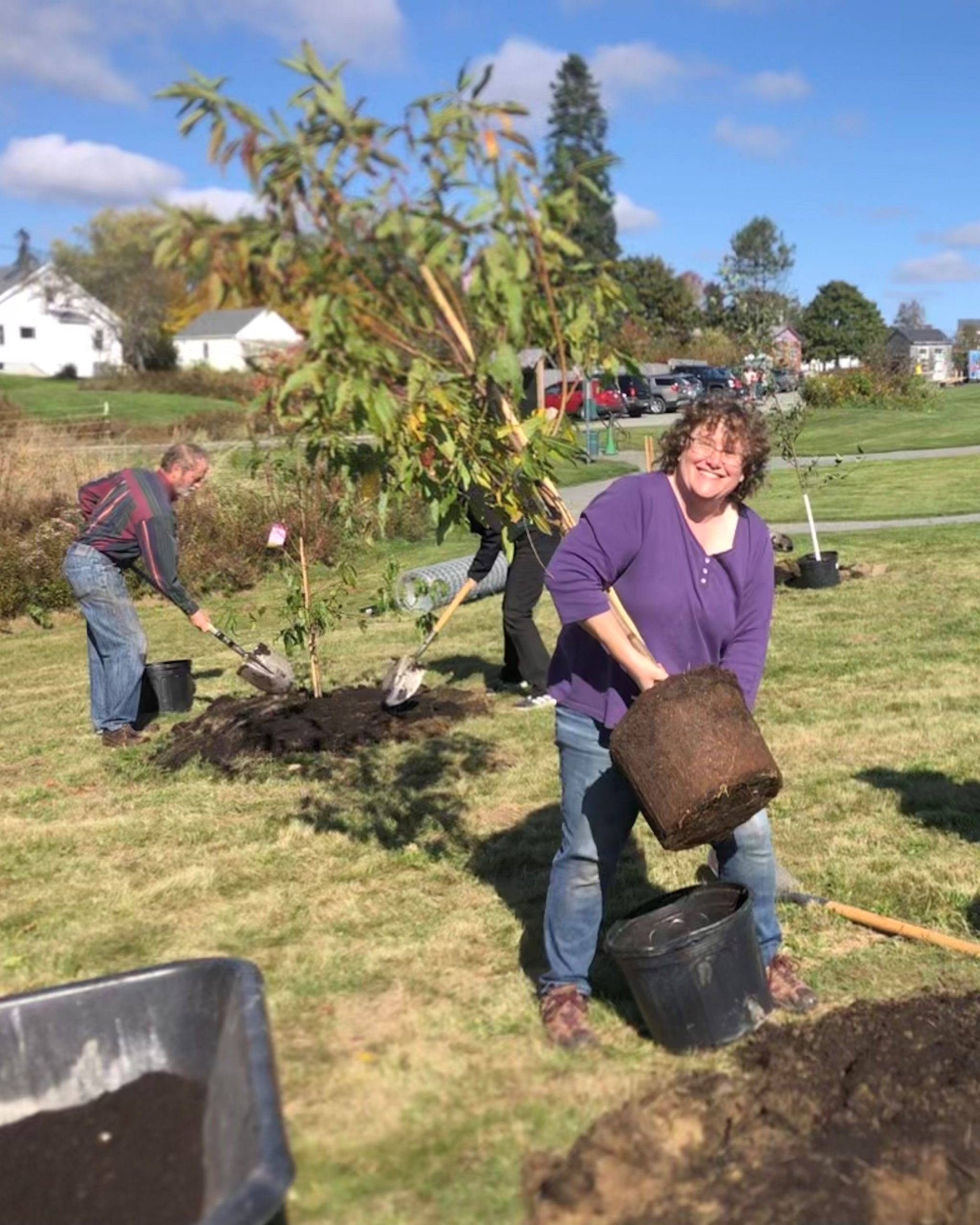Picture your community transformed. In place of drab lawns around houses, town buildings, schools and businesses, there is a colorful collage of fruit and nut trees, berry bushes, perennial vegetables and annual crops — interspersed with wildflowers.
People without yards or the capacity to garden enjoy free produce from many of these settings. In municipal parks and land trust preserves, volunteers and staff cultivate larger vegetable plots, orchards and tree nurseries, where horticultural instruction takes place routinely.
“Harvest share tables” around town have fresh produce free for the taking, and residents informally exchange seeds, seedlings and crops. Gleaners help ensure that all the produce gets used, and volunteers process surplus for ready-made meals at food pantries.
Organic and regenerative practices build the soil so it can hold more atmospheric carbon and soak up heavy rains.
Elements of this utopian vision are already sprouting up around Maine through programs like Incredible Edible Milbridge, a public gardening initiative rooted in the “premise that everyone deserves healthy food,” said Chris Kuhni, who directs the sponsoring organization, Women for Healthy Rural Living. Watching people happily harvesting fresh food in the beautiful garden spaces overlooking Narraguagus Bay can feel, in her words, “like nirvana.”
Alongside bountiful produce, the Milbridge gardens have spawned unexpected generosity. “It’s hard to keep up with emptying the donation boxes at both gardens,” Kuhni said. “You see people so taken with the concept; They want to be a part of it.”
Can more of Maine enjoy freely accessible local produce? Her response is unequivocal: “I have to tell you; it wasn’t hard. This can happen anywhere.”
Growing — and coordinating — a movement
More local food production could move the state closer to three targets it has set for 2030: to cut greenhouse gas emissions 45 percent (below 1990 levels), to produce locally 30 percent of what residents consume, and to end hunger in Maine. Given food supply disruptions due to the drought out West, more turbulent weather and political upheaval, the time is ripe for a “farm your yard movement,” noted Martha Goodale, the Maine Monitor reader who suggested that we explore this topic.
The pandemic sparked a gardening boom in Maine that could expand into a larger movement supporting widescale local food production.

Demand for gardening support and resources “has been off the charts,” said Frank Wertheim, a University of Maine Cooperative Extension faculty member. Tracking the growth in local food production is hard, though, since there is no statewide data repository or association of all the local gardening initiatives.
Even within a single community, it can be hard to know what resources there are — down to the level of “pay what you can” roadside produce stands. “We have all these hidden gems,” said Jessica Breithaupt, the new food security community connector for Healthy Lincoln County: “How do we promote them?”
Statewide “connector” positions are needed as well to share resources and highlight model initiatives — such as Liberation Farms, the Somali Bantu Community Association’s community farming program for new Mainers in the Lewiston area, and Foothills Foodworks, in which community members make packaged meals for Norway residents with local ingredients. Another pioneering effort, Twin Villages Food Bank Farm in Damariscotta, cultivates three acres on a land trust preserve that supplies more than 50,000 pounds of produce annually to area food pantries and programs. “We would love this [model] to be replicated,” said farm manager Sara Cawthon.
Helping those who help the growers
Consistent support for local gardening efforts comes through Cooperative Extension, which produces a wealth of instructional videos and coordinates 4-H youth program and family-oriented Kids Can Grow introductions to gardening. It has provided nearly 1,000 individuals (myself included) 40 hours of horticultural Master Gardener Volunteer training in exchange for ongoing community service — which amounted last year to nearly 29,000 hours of time spent in local gardens — much of it in food production.

“Cooperative Extension has a far reach through the community,” said Joelle Albury, outreach manager for Maine Coast Heritage Trust’s Aldermere Farm in Rockport. In every one of the food-based community programs she has worked on over a decade, “Cooperative Extension has provided the support. It has always been a central resource.”
But Extension’s horticultural staff is stretched thin, strained by the increased demand. Wertheim, who plans to retire late this summer, fears that his position may not be replaced. He would like to see significant growth, not slow attrition.
Hannah Carter, dean of Cooperative Extension, is hopeful that grant funding and private philanthropy might help expand horticultural services, where she said more than 90 percent of budgeted funds go directly toward staffing.
Federal, state, municipal and philanthropic support
Rhiannon Hampson, the newly appointed Maine state director of USDA Rural Development, hopes that more local groups will seek USDA community facilities grants, which could support community kitchens and food hubs. While acknowledging that the application process is cumbersome, she encouraged people to seek support from local USDA staff. Local groups can also potentially benefit from USDA Rural Business Development Grants, which can go to eligible statewide organizations that then offer seed money to local groups.

The Department of Agriculture, Conservation and Forestry (DACF) focuses primarily on commercial agriculture, according to Craig Lapine, a special assistant to the Commissioner, but it “does want to support a relocalized [food] system.” One way it could do that would be to create something akin to the Appalachian Beginning Forest Farmer Coalition to help Mainers grow native understory plants like edible ramps and medicinal herbs.
DACF could also reestablish the subsidized state nursery Maine once had, offering affordable seedlings at a time when trees and shrubs are in short supply. The New Hampshire State Forest Nursery has more than doubled the number of seedlings sold and nearly doubled its number of customers over the last five years.
Towns could offer local garden initiatives in-kind support such as use of town-owned lands, loan of vehicles, or staffing support from public works for tree plantings. Some of the state’s food councils are working to revise ordinance language so that towns can reduce barriers to local food production, permitting — for example — backyard chickens and greenhouses.
Some Maine foundations have given consistent support to local food initiatives, and Jonah Fertig-Burd, community partner for food systems at the Sewall Foundation, said a group of food funders recently began meeting to discuss how they might work collectively to “make a healthy, equitable and just food system.” (Disclosure: the Sewall Foundation provides financial support to the Monitor.)
The need for a broader and deeper change
Beyond the mechanics of support lies a bigger challenge, Fertig-Burd said: to reassess “what role food production plays in the social fabric of our communities and our state.” While food is widely recognized as a universal right, our societal structures and priorities don’t always support it. “Could we use some of our public departments and agencies to support community gardens and people growing food?”
As Maine increases production of community-based foods, it should incorporate the wisdom of the Wabanaki people who for millennia have cared for these lands. Alivia Moore, co-founder of Eastern Woodlands Rematriation — a collective of indigenous food and medicine producers, underscored the need for a strategic expansion of local food systems to engage indigenous leadership.
“The way we feed and nourish ourselves,” Moore said, “is the blueprint for how we relate to the earth.”








